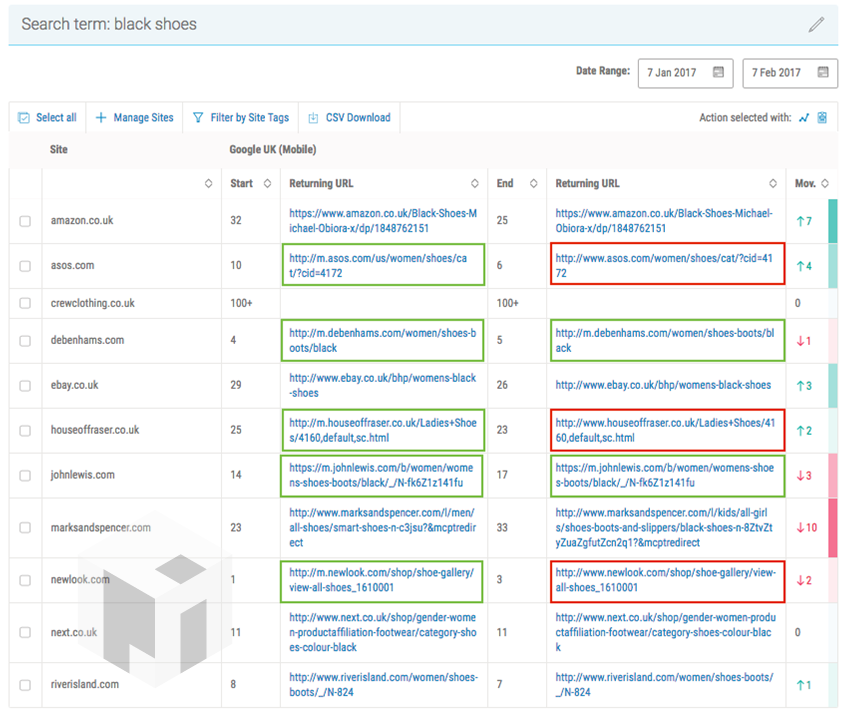What’s been going on with Google’s mobile indexing?
Back in October, Google announced the impending rollout of a mobile-first search index, a sure to be massive overhaul of the way Google indexes its search results which has had SEOs scrambling to prepare their businesses.
In fairly typical Google fashion, a few months on from the announcement, we’re still no closer to a definitive date on when the change will take place. But some strange behaviour in mobile search results, combined with turbulent search ‘weather’ over the past few days, indicates that we could be approaching a launch.
What happened?
The first sign that something a little strange was happening came on Monday 6th February, when Glynn Davies, Head of Search Strategy at Pi Datametrics, noticed separate mobile sites dropping out of mobile search on Google, to be replaced with their desktop versions.
Noticing separate mobile sites dropping out of Google Mobile in favour of desktop versions across several major sites… #seo #mobile pic.twitter.com/LYoEVNUgOn
— Glynn Davies (@glynndaviesesq) February 6, 2017
As alarming as it might seem, this situation isn’t without precedent on Google. Google confirmed back in 2015 that it uses the desktop version of a site for ranking on mobile, while still comparing the two to check for any major discrepancies (such as users creating a spammy desktop website purely for the purposes of ranking high).
And last November it was revealed that desktop pages might be ranked over AMP (Accelerated Mobile Pages) in certain circumstances in the upcoming mobile-first index.
Still, this sudden switch seemed unprecedented, and Mozcast’s weather report – which reflects the current turbulence of Google’s algorithms by how hot and stormy the weather is – was showing some distinctly tempestuous weather on Sunday 5th and Monday 6th November.
Image: Mozcast
There was some speculation on Twitter as to whether this could be due to Google’s recently-implemented penalty against intrusive mobile interstitials, but there appeared to be no link between the presence of interstitials and the sites which were being affected.
@glynndaviesesq Think it's because of interstitials?
— Britney Muller (@BritneyMuller) February 6, 2017
Of course, in these situations one of the best ways to gain clarity is to ping Google on Twitter. As it happened, Twitter user Vishal Marathe had already contacted John Mueller, Google’s webmaster trends analyst, a few days earlier about the same issue. Mueller’s theory was that the swap in rankings might be due to a problem in the way the sites themselves were set up.
@VishMarathe411 Happy to look at examples. My guess is the sites might not be set up correctly.
— John ☆.o(≧▽≦)o.☆ (@JohnMu) February 3, 2017
Glitchy Google
Pi Datametrics tracked the ranking of the affected sites on both mobile and desktop with its data-driven SEO platform, in order to try and determine what might be causing the change. Glynn Davies explained Pi’s thinking in trying to determine the cause:
“Our first suspicion on noticing this was an error in configuration that was being “punished” by Google’s switch to mobile-first indexing. Google recommend a bi-directional rel=“canonical”/rel=“alternate”, which identifies the relationship between equivalent but separate mobile and desktop pages.
However, that doesn’t appear to be the cause. Some affected sites are correctly configured, others appear not to be. Plus, all examples we’ve seen conditionally redirect, i.e. clicking the desktop site result on a mobile device will pass the user back to the mobile site.”
An image from Pi Datametrics’ platform highlighting the sites that were affected by the mysterious change – and those which weren’t. | Image: Pi Datametrics
Fashion retailer ASOS is one of the brands whose sites were affected by the switch in rankings. Image: Pi Datametrics
Major fashion retailer ASOS was one of those affected, and its mobile and desktop sites exhibited some particularly strange behaviour with regard to US and UK search. Davies explained:
“One of the examples, a large fashion retailer (ASOS), is further complicated by the fact that the US mobile page ranking 1st in UK mobile search has been replaced by the UK desktop equivalent (which now still redirects to the US version when accessed through SERPs).
In short, there doesn’t appear to be either a clear cause or a reason why some are affected while others aren’t.”
Things became significantly clearer when, on Wednesday 8th February, John Mueller tweeted to confirm that this was in fact a glitch (or “quirk”) on Google’s end, rather than intentional behaviour, and that Google was actively looking into the issue.
@razbithume yeah, looks weird :). We noticed too and are looking into it on our side. Seems like a quirk on our side.
— John ☆.o(≧▽≦)o.☆ (@JohnMu) February 8, 2017
As of right now, the glitch seems to still be ongoing while Google looks into things. There is a chance that the issue could be unrelated to mobile-first indexing – after all, Google has any number of algorithm updates, both big and small, in the pipeline for throughout the year – most of which we won’t even know about until they’re on top of us. Mobile-first indexing just happens to be a major one that we know is coming.
But given the fact that this glitch affects mobile sites specifically, and the timing of it, it doesn’t seem too far-fetched to conclude that it could be the result of tests that Google is carrying out ahead of a full implementation of the new index.
source https://searchenginewatch.com/2017/02/09/whats-been-going-on-with-googles-mobile-indexing/

